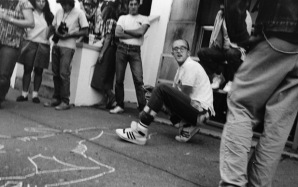Keith Haring was born on May 4, 1958 in Reading, Pennsylvania, and was raised in nearby Kutztown, Pennsylvania. He developed a love for drawing at a very early age, learning basic cartooning skills from his father and from the popular culture around him, such as Dr. Seuss and Walt Disney.
Haring moved to New York City and enrolled in the School of Visual Arts (SVA). In New York, Haring found a thriving alternative art community that was developing outside the gallery and museum system, in the downtown streets, the subways and spaces in clubs and former dance halls. Here he became friends with fellow artists Kenny Scharf and Jean-Michel Basquiat, as well as the musicians, performance artists and graffiti writers that comprised the burgeoning art community. Haring was swept up in the energy and spirit of this scene and began to organize and participate in exhibitions and performances at Club 57 and other alternative venues.
Around 1980, Haring became inspired by “cut-up” art-or word juxtaposition-techniques. Using headline type gathered from the New York Post, he created a series of fake headline pieces with absurd messages such as “REGAN SLAIN BY HERO COP”, “REGAN’S DEATH COP HUNTS POPE”, and “POPE KILLED FOR FREED HOSTAGE”. He xeroxed hundreds of copies of these and pasted them onto lampposts throughout Manhattan Between 1980 and 1989, Haring achieved international recognition and participated in numerous group and solo exhibitions. His first solo exhibition in New York was held at the Westbeth Painters Space in 1981.
Throughout his career, Haring devoted much of his time to public works, which often carried social messages. He produced more than 50 public artworks between 1982 and 1989, in dozens of cities around the world, many of which were created for charities, hospitals, children’s day care centers and orphanages. The now famous Crack is Wack mural of 1986 has become a landmark along New York’s FDR Drive.
Keith Haring’s work is a great example of taking over public spaces with art to make a statement. That is exactly what we did with our Debt Fence. I think that Haring was able to use very unique mediums that grab people’s attention during their day-to-day routines. For example, his fake newspaper headlines caught people’s attention and made them think and could be placed in multiple areas around New York City. Those cutouts are similar to our signage. We were able to post them around school on bulletin boards and also on our fence to grab students attention on their way to class.  Students are used to looking at posters for ads for different events on campus and I think having literature in the same format to promote information on student debt is both surprising and effective.
Students are used to looking at posters for ads for different events on campus and I think having literature in the same format to promote information on student debt is both surprising and effective.
For more information on Keith Haring check out this PowerPoint presentation done by Erica and myself.


